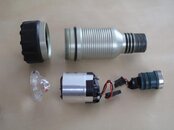Sounds like you're on the right track, but I just wanted to clarify for potential future readers that if making/retrofitting an existing metal-bodied light, the only way to shed heat is through the light body and into the water. The goal of the design, then, is to find the most efficient way to transfer this heat from the LED to the light body (which in turn transfers the heat into the water). Any inefficiencies, such as air-gaps, will just cause the insides to heat up.
Metal-to-metal contact is the best way to do this (from the metallic circuit board holding the LEDs to an intermediate piece of metal, and then to the light body itself). Here's what I did when replacing the HID with an LED in my dive light: (Disclaimer: I'm an electrical design dork)
View attachment 171766
The silver thing in the bottom centre is a round piece of aluminium (wrapped in aluminium-tape to bring it up to the correct diameter for a snug fit in the light body), which I screwed the LED board onto (on the left). The driver is on the right, cheaply held on by electrical tape

. I used thermal-paste between connections to reduce thermal resistance further.
The XP-G2 LED itself is rated for 150 degrees maximum, the driver components probably less. Realistically, you can drive things hot, and may never notice the effects like reduced light output, reduced life-span (which could still be longer than you'd use the light for anyway). It's easy to do an insufficient job of it, which can cause you to blow past these thermal limits (i.e. if you turn those LEDs on at maximum current with the PCB sitting in air, they'll burn out, very fast). However, it's also very easy to "overkill" the thermal design, as I did above for at least the LED portion, and then you get great performance and don't have to worry.





